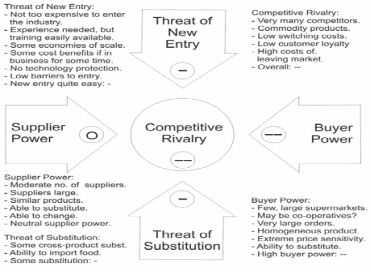Introduction
The five forces proposed by Porter are very essential in the understanding of a firm’s competitive position within an industry. The tools are simple but powerful in analyzing the business competitive situation (Cheverton 2004, p.113). Porter’s five force tools are not only used in determining the current competitive position of the firm but also in the understanding of the future competitive status of the business establishment (Cheverton, 2004), that is, its products or services strengths and weaknesses. With this knowledge, the businesses can take the advantage of their strengths and increase their gains, develop on their weak points and avoid making mistakes in their decisions (Porter, 1998). In other words, Porter’s five forces model is a very important tool in investment decisions.
Typically, most firms use this tool to establish the effectiveness of new products before they are brought into the market (Porter, 1998). Moreover, the tools are very useful to firms that want to diversify in other areas as well as those that want to introduce new products into the market. However, in certain situations, the tools will not be very applicable (Porter, 1998).
Understanding the model
The assumption of the tool is that there are five vital forces that establish the business’s competitive power. They include supplier power, buyer power, the threat of new entry, the threat of substitution, and competitive rivalry (Porter, 1998).
The supplier’s power
Suppliers are entities that bring in products or raw materials in the business. The products or components that are brought into the business determine the profitability of the business. In circumstances where the suppliers have greater bargaining power the firm becomes less attractive. In other words, the business must evaluate whether the suppliers can easily cause the prices of products to increase (Cheverton, 2004). In the course of the evaluation, the company will look at the number of dealers in vital contribution sectors, the supplier’s influence, the exclusivity of the product being supplied as well as the expenses that may be incurred while altering the sources of supply (Karloef, 2005). In essence, the more bargaining power the suppliers have over the business the less competitive advantage the business has.
The buyer’s power
In this tool, the business must evaluate the capability of the buyers to reduce prices of the products or services down (Porter, 1998). Similarly, factors such as the cost of changing the buyers, the number of buyers the business have, their character and uniqueness are used to evaluate the power of the buyer. In cases where the business deals with few but powerful buyers, they will likely dictate terms that work on the disadvantage of the business (Karloef, 2005).
Threat of substitution
This is where the products or services of the business can easily be substituted. In circumstances where the products or services can easily be substituted the business competitive power is weak. The increased substitutability of the product lowers its attractiveness as well as limits its prices (Porter, 1998). In effect, the firm’s attractiveness also decreases hence there is the profitability. The substitutability of the products depends on the willingness of the buyers to go for the substitute, the prices relative to the substitute and the cost of switching to the substitute (Karloef, 2005)
Competitive rivalry
The number, their capabilities and the quality of the products that the competitors offer are the most important consideration (Porter, 1998). In circumstances where the competitors are many and are capable of providing quality products the business has little competitive advantage. In such a situation, the business must either lower prices or apply other strategies to remain competitive. This might be costly to the firm. On the other hand, when the business products are unique, then the business has increased competitive advantage.
Entry threat
The competitive power of companies is influenced by the aptitude of other entity to penetrate the market (Porter, 1998). In circumstances where the cost of entry is less then the business competitive advantage is reduced. In other words, if there are few economies of scale, little capital is needed to enter the market, technological competencies of the business can easily be counterfeited, then new competitors can easily enter the market and weaken the position of the business (Cheverton, 2004). In the contrary, strong and durable barriers to entry normally preserve the business competitive position.
Analysing the competitive position of Woolworth and BHP
Using these five forces, the competitive positions of BHP and Woolworth in their respective industries can easily be analysed. As indicated in the appendix, BHP being a firm within the materials industry will face threat of new entry, competitive rivalry and strong buyer’s power. However the company will have low suppliers power and threat to substitutes. Woolworth will similarly have to face strong competitive rivalry, strong buyer’s power, and strong supplier’s power, threat of substitution but low threat to new entries into the business. The evaluation will enable the firms to know their strength, position as well as their abilities to remain profitable in their respective industries.
References
Cheverton, P 2004, Key marketing skills: strategies, tools and techniques for marketing success, Kogan Page, London, UK.
Karloef, B 2005, A to Z of management concepts and models, Thorogood, London, UK.
Porter, EM 1998, Competitive strategy: techniques for analyzing industries and competitors, Simon and Schuster, New York, NY.
Appendix

